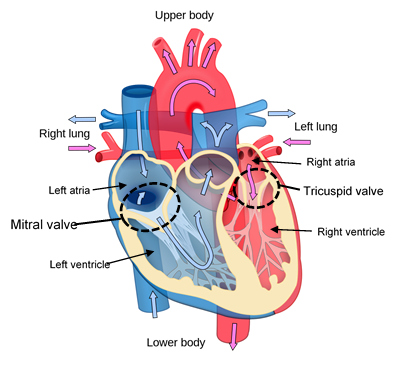
Mar 5, 2020 | Pet Handouts
Getting your first puppy or kitten can seem a little daunting to some. There are so many thing you have to think about. We want you to be able to enjoy every moment with your new loved one without having to worry about the rest. At Apex, we have put together a handy booklet for your new furry friend to guide you along what you need to know with regards to their health.
You may download the booklet here, and feel free to give us a call if you ever have questions.
Sep 18, 2019 | Pet Handouts
How does the heart work?
The heart consists of four chambers. The upper chambers are the right and left atria. The lower chambers are the right and left ventricles.
Blood flows from the body into the right atrium. It is then pumped into the right ventricle. The right ventricle pumps blood into the lungs, where it receives oxygen. It flows from the lungs into the left atrium; it is then is pumped into the left ventricle.
What is the mitral valve?
Each side of the heart has a valve that prevents blood from flowing backwards. The mitral valve is the valve separating the left atrium and the left ventricle. The tricuspid valve is the valve separating the right atrium and ventricle.
Because of the very large pressure created when the left ventricle contracts, the mitral valve can wear out in many dogs. This wearing out process begins with a small leak that gradually gets more severe. Disease of the tricuspid valve can occur as well, especially with progression of heart disease, though mitral valve disease is usually seen more commonly.
How does heart failure occur?
When the mitral valve leaks, it creates turbulence from the backflow of the blood. This can be heard as a heart murmur on auscultation and is usually the first sign noted of heart disease.
Over time, the leak can become more severe, causing more blood to backflow. This affects the pumping efficiency of the heart and leads to congestive heart failure.
When the mitral valve is affected, this increase of pressure on the left side of the heart causes fluid to leak into the tissues of the lungs. Increased of fluid in the lung tissues causes an accumulation of fluid in the lungs (pulmonary oedema) which leads to coughing, difficulty breathing and intolerance when exercising.
What tests are done to assess the situation?
There are several tests that are used to give the best evaluation of the heart function. Our veterinarian will explain and discuss these with you accordingly.
- Physical Examination and listening with a stethoscope (Auscultation) . Physical examination allows us to assess your pet for any abnormal findings, including their breathing pattern. Auscultation allows identification of murmurs, their location, and their intensity. It also allows us to hear lung sounds and if there is any fluid accumulation.
- Chest radiographs (X-rays). Chest radiographs are important to examine the size and shape of the heart. Radiographs will help us examine the lungs and if there is fluid accumulation present. Monitoring of these signs for any change is important in patients with heart disease.
- Ultrasound examination (Echocardiogram). Ultrasound examination allows us to examine the inside components of the heart in real time. This allows direct visualization of the valves and the other structures of the heart.
- Blood and urine tests. These tests allow detection of other disorders in the body that can impact on heart function such as kidney or liver disease. The knowledge of other organ function is also important in the treatment and response to medications.
- Electrocardiogram (ECG). This helps to assess the electrical activity of the heart to determine if any abnormal rhythms (arrhythmias) are present.
What treatment options are there?
A leaky heart valve can be replaced surgically in people. However, this is not as available in animals as of yet. Medical therapy and close monitoring is therefore crucial in these patients to manage their disease as best we can.
Several different drugs are used to treat and manage heart failure. These medications work in different ways with the ultimate aim to reduce the workload on the heart, so as to improve heart function. The results of the various tests will determine which medications are appropriate for your pet.
What can I do at home?
Close monitoring is an important step in determining the state and progression of heart disease. This, together with regular reviews, is important in ensuring the current medical regime is working for your pet or if it needs to be altered.
A good way to monitor at home is to monitor your pet’s “Sleeping/Resting Respiratory Rate (SRR/RRR)”. This is an excellent way to monitor heart disease as well as responses to medications. This should be started initially every 2-3 days in the initial phase followed by once-twice weekly.
Click here for our SRR instruction and monitoring sheet.

Sep 18, 2019 | Pet Handouts
The function of the kidney
Kidneys have multiple functions. Their main job is to remove the waste products from the blood in the form of producing urine. They also help to maintain electrolyte and nutrient levels in the blood.
Chronic kidney disease
The kidneys have a large amount of spare capacity to perform their functions. Thus at least 70% of the kidney needs to be affected before clinical signs are seen. This means the damage has been slowly occurring over some time before diagnosis.
In the initial stages, the kidneys cope by excreting the waste products at a lower concentration but over a larger volume. However, once the disease progresses, the rate of removal reduces and causes a sudden elevation of waste products in the bloodstream and the sudden onset of severe disease.
What are the causes of CKD?
Numerous disease processes can lead to chronic kidney disease, including congenital malformations, infections, cancer and degeneration. Chronic kidney disease is the end stage of varying disease processes rather than a specific cause on its own.
How is the disease diagnosed?
Chronic kidney disease is usually diagnosed by identifying the two waste product levels, Urea (BUN) and creatinine (Crea), in the bloodstream. These markers are usually seen elevated when kidney dysfunction has become severe (70%) due to the kidney’s inability to cope leading to an increased level of waste products in the bloodstream.
Other blood values, such as phosphorus, potassium and red blood cell counts are also important to determine the extent of kidney dysfunction. A urine analysis will also allow us to check the concentration of urine, blood and protein presence which will all help us to identify the extent of dysfunction.
In recent years, there has been a new blood test marker, SDMA, that allows us to identify kidney disease in its early stages (~35%). This marker is useful to allow us to identify kidney dysfunction before it reaches a severe stage.
How does CKD affect my cat?
Because the kidneys perform a variety of different functions, the clinical signs of kidney disease can vary. The most common changes noted are weight loss, poor hair quality, in appetence, halitosis (bad breath), lethargy. Patients can also drink and urinate more but this is less commonly seen. Vomiting and diarrhoea are other clinical signs that can present.
Is it curable?
Unfortunately, once damaged, kidneys have a very limited ability to recover. Treatment is aimed to stabilize and manage the dysfunction to allow a slower progression of disease. As such, chronic kidney disease requires long term management, but if managed well, patients can retain a good quality of life.
What treatments are available?
Depending on the blood results and your pet, several different treatments may be required to treat the different problems that arise. The extent of treatment will vary depending on the presentation of your pet and the severity of disease. Our veterinarians will assess your pet and explain to you each step accordingly. The following is a list of treatments that may be required in a kidney disease patient.
- Fluid Therapy
As most kidney disease patients are dehydrated and unable to maintain their hydration as well. Fluid therapy is usually crucial in initial phases to stabilize a patient. Depending on the severity of disease, our vets may recommend an initial hospitalization period to allow intravenous fluid therapy (aka drip). Patients may also require to be maintained on fluid therapy subcutaneous injections at home, depending on their situation.
- Diet changes
Low protein and phosphorus diets are very useful to reduce the level of waste products, thereby reducing the load on the kidneys. Special diets are available for such purposes, e.g. Royal Canin Renal & Hills k/d.. They come in both wet and dry forms. Gradual introduction is recommended and even warming the food initially to increase its palatability.
- Phosphate Binders
Reducing blood phosphate can have a major effect in improving well-being and slowing disease progression. These medications are mixed with food and may be recommended depending on your pet’s test results.
- Hypotensive & Anti-proteinuria drugs
Large number of patients have high blood pressure from kidney disease, as well as an increased loss of protein in the urine. Medication may be required to lower the blood pressure and reduce the protein loss from the urine as well.
- Anaemia
The kidneys secrete a hormone that stimulates red blood cell production. Kidney disease patients may have a low red blood cell count (anaemia) due to the reduction of red blood cell production. An injection of this hormone can be given in cases that require it.
- Antibiotics & Other Medications
Depending on your pet’s presentation and results, antibiotics may be required if a secondary infection is suspected. Other medications may be required depending on your cat’s symptoms and presentation.



